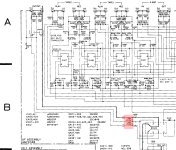Hello
What kind of capacitors are these Blue caps on a Photo? What brand? According to Service manual these are Polystyrene film capacitors and thats the only info

What kind of capacitors are these Blue caps on a Photo? What brand? According to Service manual these are Polystyrene film capacitors and thats the only info
OK heres close up. Markings on a caps, 102JWhy no close ups to aid identification?
No. Mine are not chinese or knock offs from aliexpress. As far as I know this preamp wasnt recapped So these are original polyestyrene caps from 80s
OK 102 is 10 with 2 zeros after, so 1nF. They are ceramic, not polystyrene. The J after means +/-5% tolerance, so they are probably COG/NPO dielectric.
Why are you interested?
Why are you interested?
The brand of the unit may give a clue to the manufacturer of those 1nF caps .
Since they are poly’s they should be still in good condition, and should not need recapping even today .
The only time I have seen poly caps loose their capacitance is when they are exposed to mains voltages .
This type of issue is common to Yamaha integrated amps , in their stand by cct .
They use a poly cap (instead of a transformer ) to drop the mains voltage to feed the always on stby cct .
But I digress .
Mil
Since they are poly’s they should be still in good condition, and should not need recapping even today .
The only time I have seen poly caps loose their capacitance is when they are exposed to mains voltages .
This type of issue is common to Yamaha integrated amps , in their stand by cct .
They use a poly cap (instead of a transformer ) to drop the mains voltage to feed the always on stby cct .
But I digress .
Mil
They are NOT polystyrene! They look nothing at all like polystyrene capacitors. They are ceramic!
Unit is pioneer Elite c90The brand of the unit may give a clue to the manufacturer of those 1nF caps
They are Polystyrene according to pioneer tuning fork.They are NOT polystyrene! They look nothing at all like polystyrene capacitors. They are ceramic!
These are Polystyrene film capacitors
And these are Polystyrene film capacitors
Thats great. Id like my gear to be in original state.Since they are poly’s they should be still in good condition,
You got dozens of nasty old electrolytic capacitors to worry about. Why are you asking about mp caps which do not age?
You have no scale on your images. The radial green capacitors are polyester, and will be physically much much larger than the small blue things on your unit. The second one that you show is indeed polystyrene, 6.8nF 5% 64V. And that is what polystyrene capacitors look like.
I do know what I'm talking about here - I've spent much of my four decades working life in electronics design and development.
If you insist on not believing that the tiny blue things on the circuit board are ceramic, I really can't help you further.
I do know what I'm talking about here - I've spent much of my four decades working life in electronics design and development.
If you insist on not believing that the tiny blue things on the circuit board are ceramic, I really can't help you further.
Best I can tell the service manual lists them C485 and C486 part number cqsxa102j160 without specifying type. A vendor stocking Pioneer replacement parts just shows it as a generic film. How were you able to determine type?
These caps are on the output side of the preamp's output muting relay. Switching protection maybe, I'm not familiar with this use. If they are polystyrene it's not worth changing.
These caps are on the output side of the preamp's output muting relay. Switching protection maybe, I'm not familiar with this use. If they are polystyrene it's not worth changing.
Attachments
Because that is what ceramic capacitors look like. I'm sat looking at a bag of them of the as I type. These are smaller, because they are only 50V parts - 0.1uF, 50V X7R. X7R are much smaller because they are X7R ceramic is high-K and results in a smaller part. They are suitable for decoupling, but rubbish for audio use.
Which is why I think that the ones in the photo are COG/NPO dielectric. This is a low-K ceramic, and is entirely suitable for audio use. In measurement you would be hard pushed to measure any difference at all (electrically) between a COG/NPO ceramic capacitor and polystyene.
Yup - here you go from Mouser. 1nF 100V COG ceramic. See any similarity? https://www.mouser.co.uk/ProductDetail/TDK/FA18C0G2A102JNU00?qs=zFwFjAF3uagjA4TGPW3PXA==
The ones that are fitted are 160V, and the ones in the link above are 100V - but I think I've banged on enough on this one.
Guys - believe what you like.
Which is why I think that the ones in the photo are COG/NPO dielectric. This is a low-K ceramic, and is entirely suitable for audio use. In measurement you would be hard pushed to measure any difference at all (electrically) between a COG/NPO ceramic capacitor and polystyene.
Yup - here you go from Mouser. 1nF 100V COG ceramic. See any similarity? https://www.mouser.co.uk/ProductDetail/TDK/FA18C0G2A102JNU00?qs=zFwFjAF3uagjA4TGPW3PXA==
The ones that are fitted are 160V, and the ones in the link above are 100V - but I think I've banged on enough on this one.
Guys - believe what you like.
Bingo! Thank heavens someone else recognizes the thingsThey are most probably multilayer ceramic.
This preamp is a 35 year old design. I don't recall any ceramic or polystyrene caps like that a generation ago.
The HK Citation I tube preamplifier used ceramic disc capacitors for signal coupling.
Even at the phono inputs.
Even at the phono inputs.
One looks like a 1nF 5% film type.
- Home
- Design & Build
- Parts
- Polystyrene film capacitors from 80s
